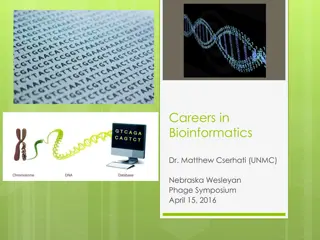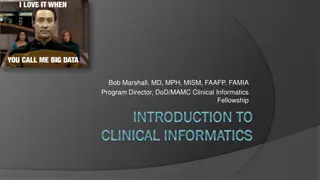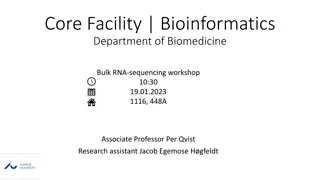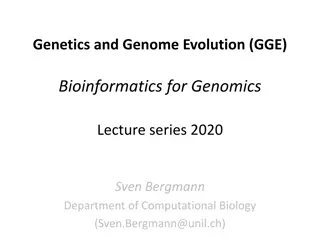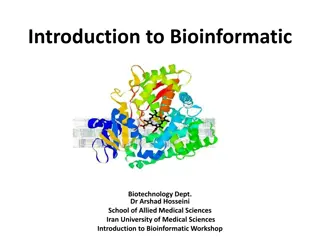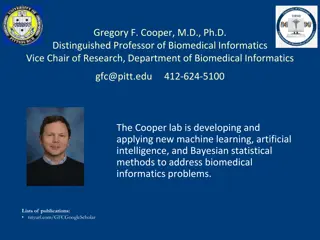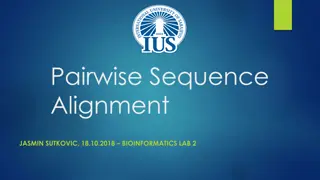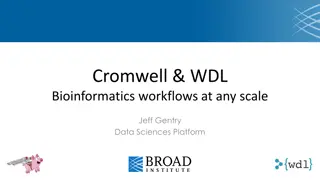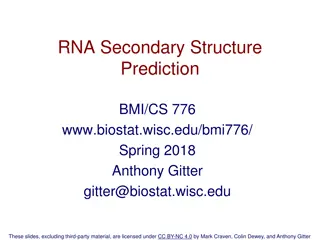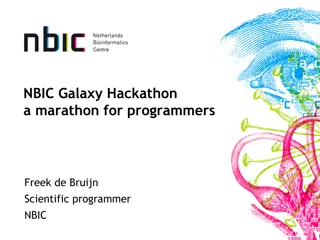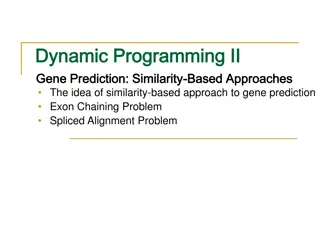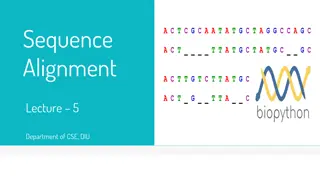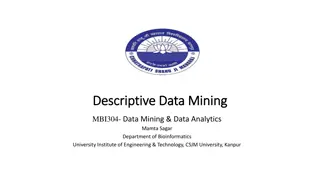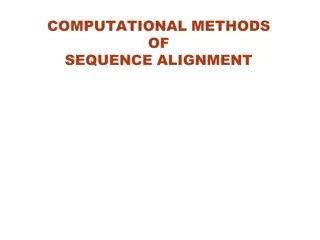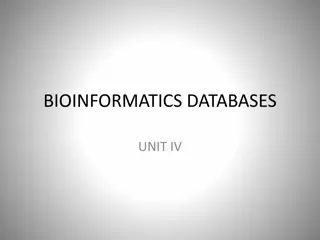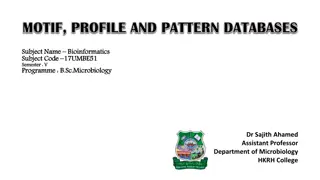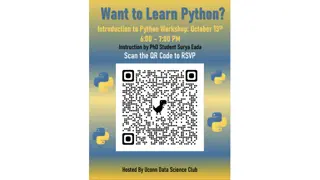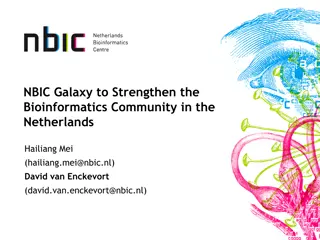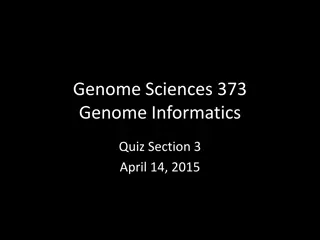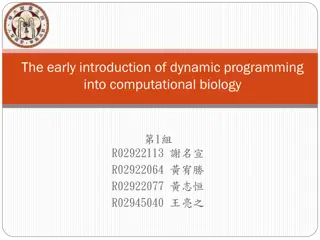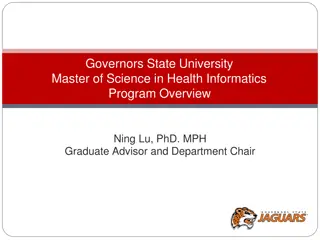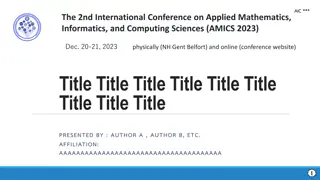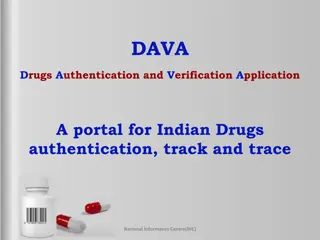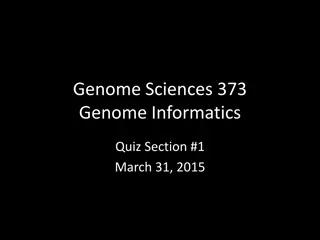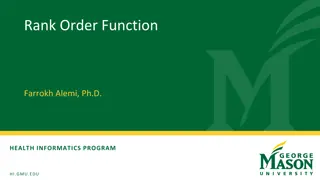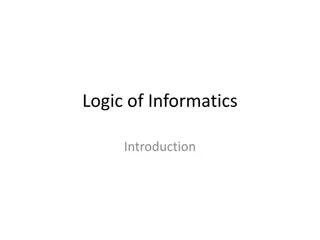Overview of Bioinformatics Topics in Informatics and Biology
Bioinformatics covers various topics such as informatics, biology, programming, statistics, and operating systems. It emphasizes the importance of skills in data management, programming, and statistical analysis for interpreting experimental data types like DNA sequencing and protein structures.
Download Presentation

Please find below an Image/Link to download the presentation.
The content on the website is provided AS IS for your information and personal use only. It may not be sold, licensed, or shared on other websites without obtaining consent from the author. Download presentation by click this link. If you encounter any issues during the download, it is possible that the publisher has removed the file from their server.
E N D
Presentation Transcript
Bioinformatics Topics Ali.I.Alsaid, B.Sc Biotech Teaching Assistant Omdurman Islamic University
Bioinformatics Topics Informatics Biology Operating Systems Windows, Macintosh both offer an intuitive GUI familiarity can be assumed? Linux with a Windows like GUI interface also, familiarity can be assumed? Linux command line! complexity is overstated, but some instruction is required. All OS options are conceptually identical enabling control over files, folders, and programs. Linux command line! the only option for compute intense software.
Bioinformatics Topics Informatics Biology Programming Operating Systems Rarely is there a need to become a truly proficient programmer. BUT - Sufficient skill to affect basic management of large datasets is important. AS IS - Sufficient skill to construct simple customised pipelines. Python is currently the most popular Programming Language for Bioinformatics. Minimal programming skill levels would allow: The construction of small programs. The understanding of slightly larger programs. Ability to convey program specifications to a specialist
Bioinformatics Topics Informatics Biology Programming Statistics Operating Systems A basic understanding of Statistics is just as vital when designing an experiment. https://en.wikipedia.org/wiki/Ronald_Fisher As it is when large datasets need to be interpreted, which sensibly demands a working familiarity with a quality Statistical Package. Bioinformatics software commonly employs statistics to select the most probable answer from a set of many possible answers to a given question.
Bioinformatics Topics Informatics Biology Programming Statistics Operating Systems Data Generation Experimental Data types include : Sequences - Typically Next-Generation DNA Sequencing (NGS). https://www.ebi.ac.uk/training/online/course/ebi- next-generation-sequencing-practical-course/what- you-will-learn/what-next-generation-dna-
Bioinformatics Topics Informatics Biology Programming Statistics Operating Systems Data Generation 3D Protein Structures - X-ray crystallography or Nuclear magnetic resonance spectroscopy (NMR) https://en.wikipedia.org/wiki/Nuclear_magnetic_reso nance_spectroscopy
Bioinformatics Topics Informatics Biology Programming Statistics Operating Systems Data Generation Gene Expression Data - Microarrays https://en.wikipedia.org/wiki/DNA_microarray
Bioinformatics Topics Informatics Biology Programming Statistics Data Analysis Operating Systems The Alignment of Pairs of Homologous DNA/Protein sequences. https://www.newworldencyclopedia.org/entry/Hom ology_(biology)
Bioinformatics Topics Informatics Biology Programming Statistics Data Analysis Operating Systems The Alignment of Pairs of Homologous DNA/Protein sequences. Fundamental to most forms of DNA/Protein Sequence analysis
Bioinformatics Topics Informatics Biology Programming Statistics Data Analysis Operating Systems The Alignment of Pairs of Homologous DNA/Protein sequences. Fundamental to most forms of DNA/Protein Sequence analysis
Bioinformatics Topics Informatics Biology Programming Statistics Data Analysis Operating Systems The Alignment of Families of Homologous sequences. First, find a family of Homologous sequences.
Bioinformatics Topics Informatics Biology Programming Statistics Data Analysis Operating Systems The Alignment of Families of Homologous sequences. Then, align by inserting - s representing InDels, in each sequence.
Bioinformatics Topics Informatics Biology Programming Statistics Data Analysis Operating Systems The Alignment of Families of Homologous sequences. Next, identify the columns where Substitutions and/or InDels have been predicted.
Bioinformatics Topics Informatics Biology Programming Statistics Data Analysis Operating Systems The Alignment of Families of Homologous sequences. Then, identify the columns where full Conservation has been predicted.
Bioinformatics Topics Informatics Biology Programming Statistics Data Analysis Operating Systems The Alignment of Families of Homologous sequences. Finally Identify the Glorious Message!!!!.
Bioinformatics Topics Informatics Biology Programming Statistics Data Analysis Operating Systems Searching for Homologous Sequences in a Sequence Database. Database searching is the most common Bioinformatics process by far.
Bioinformatics Topics Informatics Biology Programming Statistics Data Analysis Operating Systems Searching for Homologous Sequences in a Sequence Database. Database searching is the most common Bioinformatics process by far. Database searching is pairwise comparison repeated many times.
Bioinformatics Topics Informatics Biology Programming Statistics Data Analysis Operating Systems Searching for Homologous Sequences in a Sequence Database. Database searching is the most common Bioinformatics process by far. Database searching is pairwise comparison repeated many times. Non-optimal comparison methods are essential for practical reasons.
Bioinformatics Topics Informatics Biology Programming Statistics Data Analysis Operating Systems Searching for Homologous Sequences in a Sequence Database. Database searching is the most common Bioinformatics process by far. Database searching is pairwise comparison repeated many times. Non-optimal comparison methods are essential for practical reasons. A list of matches, ordered by the improbability of occurring just by chance is generated.
Bioinformatics Topics Informatics Biology Programming Statistics Data Analysis Operating Systems Searching for Homologous Sequences in a Sequence Database. Database searching seeks Similarity . Users seek Homology .
Bioinformatics Topics Informatics Biology Programming Statistics Data Analysis Operating Systems Searching for Homologous Sequences in a Sequence Database. Database searching seeks Similarity . Users seek Homology .
Bioinformatics Topics Informatics Biology Programming Statistics Data Analysis Operating Systems Searching for Homologous Sequences in a Sequence Database. Database searching seeks Similarity . Users seek Homology .
Bioinformatics Topics Informatics Biology Programming Statistics Data Analysis Operating Systems Searching for Homologous Sequences in a Sequence Database. Database searching seeks Similarity . Users seek Homology .
Bioinformatics Topics Informatics Biology Programming Statistics Data Analysis Operating Systems Searching for simple sequence patterns Sequences in DNA Largely a matter of finding short sequences within longer ones. Computationally trivial. Restriction Mapping Largely a matter of finding short sequences within longer ones. https://en.wikipedia.org/wiki/Restriction_map Few Recognition Sites can be simply defined using only the codes A, C, G and T.. Detecting Restriction Enzyme Recognition Sites is complicated by their redundancy. https://www.neb.com/tools-and-resources/selection- charts/alphabetized-list-of-recognition-specificities
The solution is to use the Nucleotide Ambiguity Codes defined by IUPAC. http://www.dnabaser.com/articles/IUPAC%20ambig uity%20codes.html http://www.iupac.org/ https://en.wikipedia.org/wiki/International_Union_of_ Pure_and_Applied_Chemistry
Bioinformatics Topics Informatics Biology Programming Statistics Data Analysis Operating Systems Searching for simple sequence patterns Sequences in DNA Patterns can be derived manually to represent conserved regions of MSAs Simple where conservation is 100%
Bioinformatics Topics Informatics Biology Programming Statistics Data Analysis Operating Systems Searching for simple sequence patterns Sequences in DNA Simple Protein patterns are of limited precision. Only highly conserved regions can be described usefully. Patterns cannot weight possibilities by frequency.
Bioinformatics Topics Informatics Biology Programming Statistics Data Analysis Operating Systems Searching for simple sequence patterns Sequences in DNA Simple Protein patterns are of limited precision. Patterns do not reflect commonly accepted substitutions.
Bioinformatics Topics Informatics Biology Programming Statistics Data Analysis Operating Systems Searching for Protein properties with better models. Again, start with an MSA of instances of the feature to be modelled. Create a suitable representation of the relevant portion of MSA Compare the model along other protein sequences was illustrated for simple patterns. Where matches are detected, the corresponding protein property is likely to occur.
Bioinformatics Topics Informatics Biology Programming Statistics Data Analysis Operating Systems Searching for Protein properties with better models. A variety of simple models have been developed (e.g. Position Weight Matrices) for a number of purposes, including: - - - - - - Gene discovery in bacteria genomes (DNA) TATA box Detection (DNA) Early versions of 2D protein Structure Prediction Helix-Turn-Helix (HTH) Prediction transmembrane Alpha Helix prediction Prediction of Coiled Coils https://en.wikipedia.org/wiki/TATA_box https://en.wikipedia.org/wiki/Helix-turn-helix https://en.wikipedia.org/wiki/Transmembrane_domain http://www.ch.embnet.org/software/COILS_form.html
Bioinformatics Topics Informatics Biology Programming Statistics Data Analysis Operating Systems Searching for Protein properties with better models. The most powerful and prolific current profiles are Hidden Markov Models (HMMs) https://en.wikipedia.org/wiki/Hidden_Markov_model
Bioinformatics Topics Informatics Biology Programming Statistics Data Analysis Operating Systems Estimating evolution - Phylogeny. http://www.dictionary.com/browse/phylogeny Broadly, the estimation of evolutionary history from available evidence. Evidence does not have to be a carefully crafted MSA of Orthologous sequences from a range of organisms. However, in the context of Bioinformatics, it invariably is.
Typically, conclusions of Phylogenetic analysis are represented as Evolutionary Trees. https://en.wikipedia.org/wiki/Phylogenetic_tree Which are very Beautiful!! My personal preference is for trees that place ME as far away from a MOUSE as possible!!!!
Bioinformatics Topics Informatics Biology Programming Statistics Data Analysis Operating Systems Estimating evolution - Phylogeny. http://www.dictionary.com/browse/phylogeny Broadly, the estimation of evolutionary history from available evidence. Evidence does not have to be a carefully crafted MSA of Orthologous sequences from a range of organisms. However, in the context of Bioinformatics, it invariably is.
Bioinformatics Topics Informatics Biology Programming Statistics Data Analysis Operating Systems Estimating evolution - Phylogeny. Phylogeny is another example of an analysis One very effective Phylogenetic strategy is to seek an answer to the question: What is the most probable Evolutionary Tree, given I believe this MSA to be perfect? Reinforcing how central is the role of Statistics in Bioinformatics.
Bioinformatics Topics Informatics Biology Programming Statistics Data Analysis Operating Systems Protein structure prediction. https://en.wikipedia.org/wiki/Protein_structure_prediction Secondary Structure. https://en.wikipedia.org/wiki/Protein_secondary_structure Essentially predicting the locations of Alpha Helices, Beta Sheets and https://en.wikipedia.org/wiki/Alpha_helix https://en.wikipedia.org/wiki/Beta_sheet https://en.wikipedia.org/wiki/Turn_(biochemistry)
Bioinformatics Topics Informatics Biology Programming Statistics Data Analysis Operating Systems Protein structure prediction. Secondary Structure. Modern methods employ Machine Learning to generate Artificial Neural Networks. That is profiles computed by learning from observation of examples. https://en.wikipedia.org/wiki/Machine_learning https://en.wikipedia.org/wiki/Artificial_neural_network
Bioinformatics Topics Informatics Biology Programming Statistics Data Analysis Operating Systems Protein structure prediction. Secondary Structure. Better predictions are obtained from MSA data than from individual protein sequences. General principle being, the more information offered, the more reliable the prediction. Some systems will automatically generate an MSA if offered a solitary protein sequence. Prediction will be based on the MSA, computed by iterative database searching.
Bioinformatics Topics Informatics Biology Programming Statistics Data Analysis Operating Systems Protein structure prediction. Secondary Structure. Predicting Tertiary Structure directly from Primary Structure is not currently practical. http://www.biology-online.org/dictionary/Primary_structure De novo protein structure prediction requires better algorithms and more computing power.
Bioinformatics Topics Informatics Biology Programming Statistics Data Analysis Operating Systems Protein structure prediction. Secondary Structure. Predicting Tertiary Structure directly from Primary Structure is not currently practical. http://www.biology-online.org/dictionary/Primary_structure Homology modelling requires a reliable Tertiary Structure for a homologous protein. https://en.wikipedia.org/wiki/Homology_modeling Tertiary Structure for a protein is predicted by comparison with the homologous structure. Homology modelling is hampered by low volumes and uneven spread of available structures.
And now Once again Your turn! Some issue for consideration, discussion and reaction The Bioinformatics topics mentioned here do not constitute a comprehensive list. What would suggest is missing in order of importance? The term algorithm was mentioned once or twice. There are slightly differing definitions. Pick the one you like best and justify your selection. http://www.thefreedictionary.com/algorithm Define the three terms Homologue, Paralogue and Orthologue, being ever assiduous to ignore offensive American misspellings! https://en.wikipedia.org/wiki/Homology_(biology)#Sequence_homology http://homepage.usask.ca/~ctl271/857/def_homolog.shtml http://classroom.synonym.com/difference-between- orthologous-paralogous-genes-18612.html
The is but one basic strategy for computing Pairwise Alignments that is considered optimal. However, this strategy can be implemented to compute either Global Alignments or Local Alignments. Just informally, how do these two possibilities differ? Generally speaking, would you compute MSAs using a Global or a Local approach? Briefly justify your choice. Generally speaking, would you conduct Database Similarity searches using a Global or a Local approach? Briefly justify your choice.
Sequence alignment only makes sense for sequences representing Homologous entities A profound observation made by the ever sagacious David Philip Judge whilst sipping an eventide cup of Tesco s very cheapest tea in the penthouse suite of his Ivory Tower (personal communication, 2016.06.10). Consider and comment upon this fundamental truth. https://en.wikipedia.org/wiki/Tesco
A Multiple Alignment of Homologous sequences which were a mixture of Orthologues and Paralogues would not be suitable as input data for Phylogenetic analysis Another deep one from DPJ Consider and comment upon this further pearl of enlightenment. http://www.merriam-webster.com/dictionary/phylogenetic
The Extended syntax for ScanProsite is the most common syntax used for protein pattern definition. ScanProsite being the program for searching the of the Prosite database. Prosite was first created way back in the 1980s and, initially, was composed exclusively of protein patterns. There is no great value, at this stage, to be entirely familiar with this very simple syntax. However, from the hints in this presentation and a quick glance at the appropriate web pages, can you interpret the pattern? C{P}x(3,7)[FY](2)Wx(2)[VIL]
In the course of the dialogue for this presentation, there was mention of Accepted Substitutions , more formally referred to as Accepted Point Mutations , or if you enjoy clumsy for the sake of a pronounceable acronym, Point Accepted Mutation (PAM). How would you informally define an Accepted Point Mutation ? https://en.wikipedia.org/wiki/Point_accepted_mutation
The Extended syntax for ScanProsite is the most common syntax used for protein pattern definition. ScanProsite being the program for searching the of the Prosite database. Prosite was first created way back in the 1980s and, initially, was composed exclusively of protein patterns. There is no great value, at this stage, to be entirely familiar with this very simple syntax. However, from the hints in this presentation and a quick glance at the appropriate web pages, can you interpret the pattern? C{P}x(3,7)[FY](2)Wx(2)[VIL] http://www.pdg.cnb.uam.es/cursos/Leon_2003/pages/visualizacion/programas_m anuales/spdbv_userguide/us.expasy.org/tools/scanprosite/scanprosite-doc.html http://www.pdg.cnb.uam.es/cursos/Leon_2003/pages/visualizacion/programas_m anuales/spdbv_userguide/us.expasy.org/tools/scanprosite/index.html https://en.wikipedia.org/wiki/PROSITE
In the slides preceding, Protein Domains and Protein Sequence Motifs were mentioned with rather sparse explanation. Define both of these terms and describe simply the difference between them. https://www.ebi.ac.uk/training/online/course/introduction-protein- classification-ebi/protein-classification/what-are-protein-domains https://www.ncbi.nlm.nih.gov/pubmed/8804823 http://stanxterm.aecom.yu.edu/wiki/index.php?pag e=Protein_domains_and_motifs


